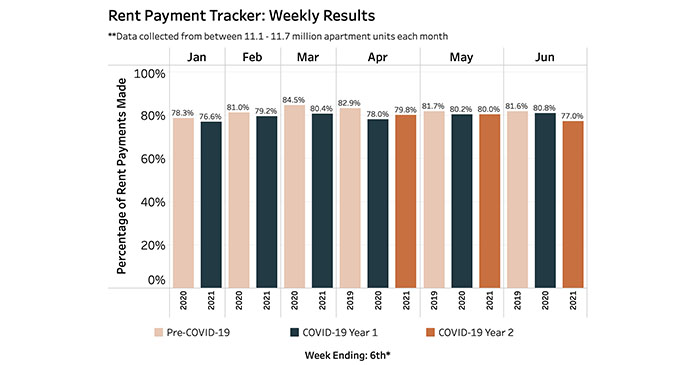The National Multifamily Housing Council (NMHC)’s Rent Payment Tracker found 77.0 percent of apartment households made a full or partial rent payment by June 6 in its survey of 11.7 million units of professionally managed apartment units across the country.
This is a 3.8 percentage point decrease from the share who paid rent through June 6, 2020 and compares to 81.6 percent that had been paid by June 6, 2019. It should be noted that June 5th and 6th fell on a weekend in 2021 and therefore may not be a direct comparison to last year’s figures. This data encompasses a wide variety of market-rate rental properties across the United States, which can vary by size, type and average rental price.
The final reading for May showed that 94.6 percent of renters made at least a partial rent payment by the end of the month. This is down slightly from the 95.0 percent who made at least a partial rent payment by the end of April and the 95.1 percent who made at least a partial rent payment by the end of May 2020.
“Today’s data is the most recent indicator of a strengthening economy, a recovering job market and robust demand in the apartment industry,” said Doug Bibby, NMHC President. “Having weathered the worst of the pandemic, we can say with increasing confidence that the outlook for the multifamily sector is as positive as it has been in years.
“However, while the long-term view is encouraging, we have significant challenges before us. Construction costs are rising at almost unparalleled rates, making it increasingly difficult to bring affordable apartment homes to market. At the same time, more and more firms are reporting significant challenges in finding labor, further delaying construction.
“Finally, federal lawmakers should be applauded for passing legislation that resulted in almost $50 billion in rental assistance funds—a top industry priority. This comes as the industry continues to work alongside its residents to keep them stably housed, setting up payment plans and helping those in need secure rental assistance. However, a national eviction moratorium remains in effect. The continuation of this policy will ultimately only serve to place insurmountable levels of debt on already struggling households. We have much to look forward to, but these challenges are real and need to be dealt with urgently.”
The NMHC Rent Payment Tracker metric provides insight into changes in resident rent payment behavior over the course of each month, and, as the dataset ages, between months. While the tracker is intended to serve as an indicator of resident financial challenges, it is also intended to track the recovery as well, including the effectiveness of government stimulus and subsidies.
However, noteworthy technical issues may make historical comparisons imprecise. For example, factors such as varying days of the week on which data are collected; individual companies’ differing payment collection policies; shelter-in-place orders’ effects on residents’ ability to deliver payments in person or by mail; the closure of leasing offices, which may delay operators’ payment processing; and other factors can affect how and when rent data is processed and recorded.
Find more information, including the methodology, on the NMHC Rent Payment Tracker.













